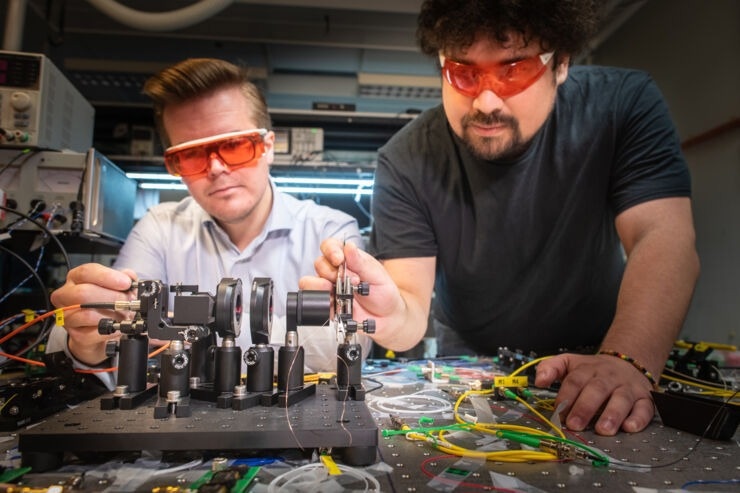At Linköping University, digital information exchange could be secure, low-cost, and highly eco-friendly using a new kind of random number generator for encryption.

Joakim Argillander and Alvaro Alarcón, Ph.D. students at the Department of Electrical Engineering, are the first authors of the paper on their quantum random number generator published in the journal Communications Physics. Image Credit: Magnus Johansson
The scientists involved in the study hope that the new technology sets the stage for a new kind of quantum communication.
In a highly connected world, cybersecurity is turning out to be highly significant to safeguard not just the individual but also banking systems and national infrastructure.
Also, there is a continuing race between hackers and those trying to safeguard the data. The most common method to safeguard information is via encryption. Hence, when one sends emails, pays bills, and shops online, the information is digitally encrypted.
For information to be encrypted, a random number generator has been utilized, which could either be a computer program or the hardware itself. The random number generator offers keys that are utilized to both encrypt and unlatch the data at the receiving end.
Impossible to Eavesdrop
Various kinds of random number generators offer various levels of randomness and hence security. Hardware is considered to be the much safer option as randomness has been regulated by physical processes.
Also, the hardware method that offers the best randomness depends on quantum phenomena —what scientists refer to as the Quantum Random Number Generator, QRNG.
In cryptography, it’s not only important that the numbers are random, but that you’re the only one who knows about them. With QRNG’s, we can certify that a large amount of the generated bits is private and thus completely secure. And if the laws of quantum physics are true, it should be impossible to eavesdrop without the recipient finding out.
Guilherme B Xavier, Researcher, Department of Electrical Engineering, Linköping University
Xavier’s research group, collaborators with scientists at the Department of Physics, Chemistry and Biology (IFM), has come up with a new kind of QRNG, that could not only be utilized for encryption but also for computer and betting simulations.
The new feature of the Linköping scientists’ QRNG is the usage of light-emitting diodes that have been made from the crystal-like material perovskite.
Environmentally Friendly and Cheap
Their random number generator comes under the best produced and compares fine with similar products. As a result of the properties of perovskites, it has the ability to be inexpensive and more eco-friendly.
For the past ten years, Feng Gao has been a professor at IFM and has been investigating perovskites. Gao believes that the recent development of perovskite light-emitting diodes (PeLEDs) implies that there is a chance to revolutionize, for instance, optical instruments.
It’s possible to use, for example, a traditional laser for QRNG, but it’s expensive. If the technology is eventually to find its way into consumer electronics, it’s important that the cost is kept down and that the production is as environmentally friendly as possible. In addition, PeLEDs don’t require as much energy to run.
Feng Gao, Professor, Department of Physics, Chemistry and Biology, Linköping University
Locally Produced
The next step is to come up with the material further to make the perovskite lead-free and to expand its lifetime, which is presently 22 days. As per Guilherme B Xavier, their new QRNG could be available to be used in cybersecurity within five years.
It’s an advantage if electronic components that are to be used for sensitive data are manufactured in Sweden. If you buy a complete randomness generator kit from another country, you can’t be sure that it’s not being monitored.
Guilherme B Xavier, Researcher, Department of Electrical Engineering, Linköping University
The study was financially supported by the Swedish Research Council, the Knut, and the Wallenberg Foundation through the Wallenberg Centre for Quantum Technology, and the European Research Council.
Journal Reference
Argillander, J., et al. (2023) Quantum random number generation based on a perovskite light emitting diode. Communications Physics. doi.org/10.1038/s42005-023-01280-3.